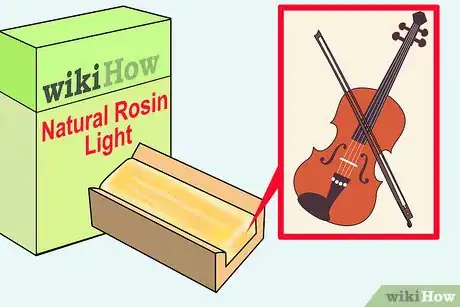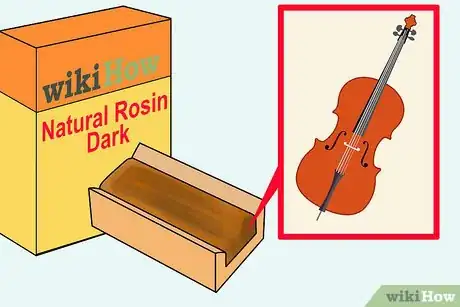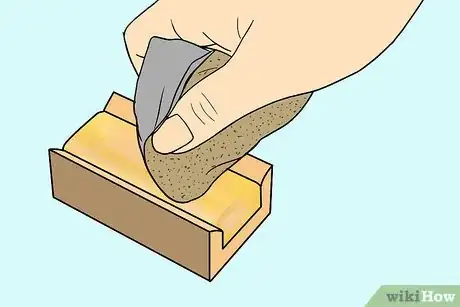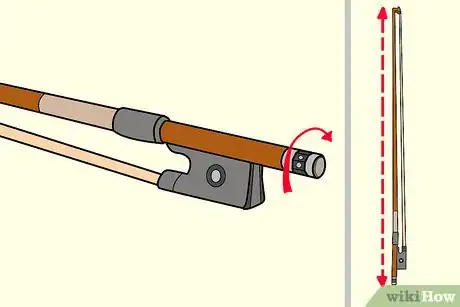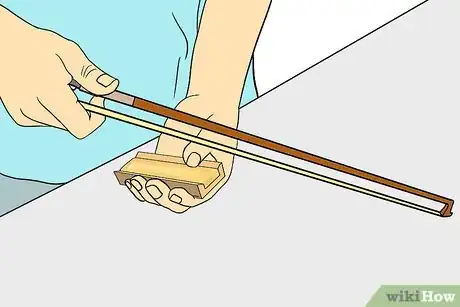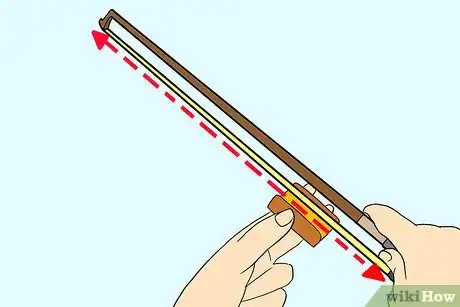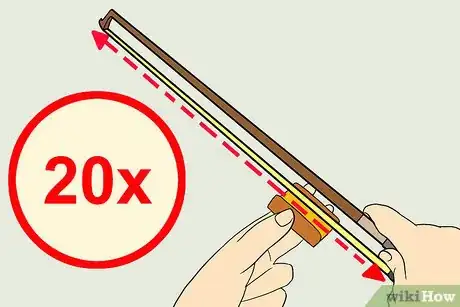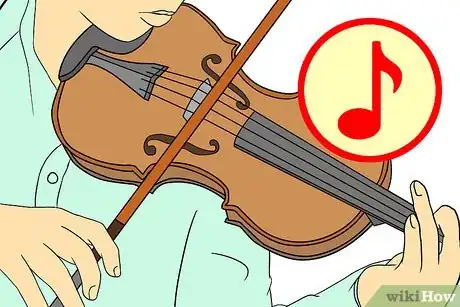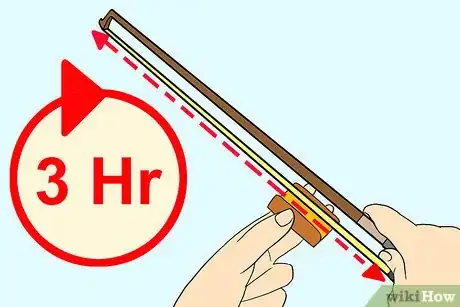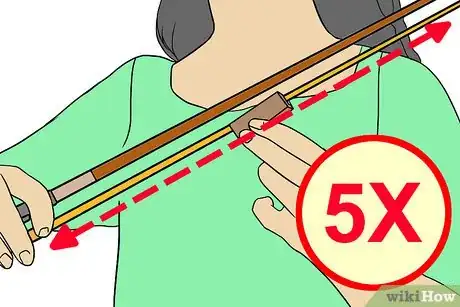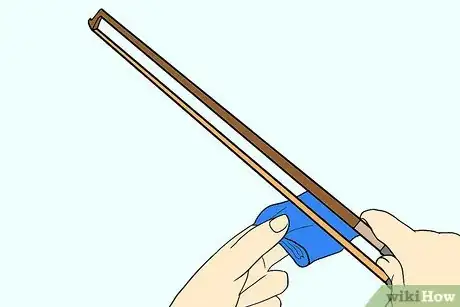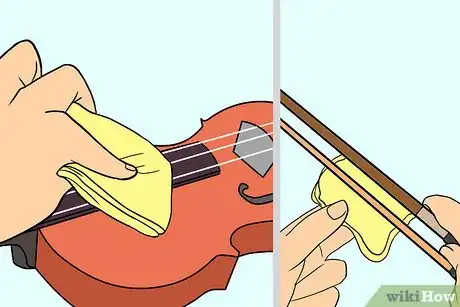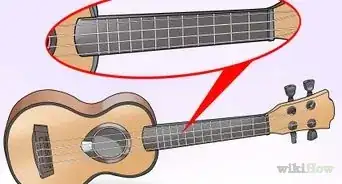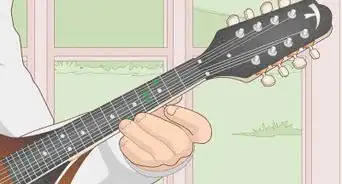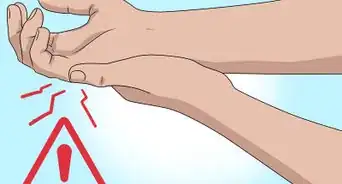This article was co-authored by Dalia Miguel. Dalia Miguel is a violinist and violin instructor based in the San Francisco Bay Area. She is studying Music Education and Violin Performance at San Jose State University and has been playing violin for over 15 years. Dalia teaches students of all ages and performs with a variety of symphonies and orchestras in the Bay Area.
wikiHow marks an article as reader-approved once it receives enough positive feedback. This article received 13 testimonials and 86% of readers who voted found it helpful, earning it our reader-approved status.
This article has been viewed 387,164 times.
A bow without rosin will produce virtually no sound when it’s drawn across the strings of an instrument. But when rosin is added to your bow, it’s able to “catch” the strings and produce vibrations, which result in the music you hear. If you’re starting with new rosin, you’ll need to rough up the surface. Then you can make your first application to a new bow or regularly apply it to an old one.
Steps
Choosing and Preparing the Rosin
-
1Buy light rosin for smaller instruments. There are different types of rosin, but the two most common are light rosin and dark rosin. Light rosin is harder, and not quite so sticky as dark rosin. It's sometimes called amber or summer rosin (for the time of year it's tapped), and it's appropriate for the higher strings, like violins and violas.[1]
-
2Choose dark rosin for a fuller sound for larger instruments. Dark rosins, or winter rosins, tend to be very sticky. The stickier the rosin is, the fuller the sound will be. Select a dark rosin if you play a low-stringed, large instrument like the cello, for which a fuller sound is preferred.[2]Advertisement
-
3Select boxed rosin for a durable, low-priced option. Boxed rosin, as its name suggests, comes in a box. This makes it less prone to cracking and breaking. It's typically only available as a light or summer rosin and is usually a lower quality than cake rosin. But its low price tag makes it a good option for beginners.[3]
-
4Opt for cake rosin for a higher-quality product. While cake rosin tends to be more expensive than boxed rosin, you're getting a purer, more high-quality rosin. It comes in a variety of colors, from amber to black, so you can select the best kind for your instrument.[4]
-
5Rub new rosin with fine-grit sandpaper to increase stickiness. New rosin needs to be roughened in order for it to stick to your bow. Take a piece of sandpaper, around 220-grit, and rub it all over the top of the rosin block. Stop when you see the rosin producing dust.[5]
- You can also use a knife to score it and cut a crosshatch pattern into the top.
Applying Rosin to a New Bow
-
1Tighten the bow. Twist the screw at the end of the bow and tighten it until it appears straight and parallel with the hairs. Then slacken it just a little until you see the curve reappear in the wood. This is the best position for the bow to be in while you play.[6]
- Don't touch the hairs or bounce them on your arm, as this will make them greasy and harder to play.
-
2Hold the rosin in your left hand and the bow in your right hand. It doesn't matter if you are right- or left-handed, as you always hold the bow in your right hand while playing. Cup the rosin block in your left hand, being sure to keep your fingers off the side you’ll be stroking the bow against.
-
3Stroke the bow all the way across the rosin. Run the bow along the rosin from the tip down to the frog (the part you hold with your hand), and then stroke it back again. Grasp the bow gently and press down just hard enough that the bow hairs produce some dust, but not so hard that you’re clenching the bow.[7]EXPERT TIPDalia Miguel is a violinist and violin instructor based in the San Francisco Bay Area. She is studying Music Education and Violin Performance at San Jose State University and has been playing violin for over 15 years. Dalia teaches students of all ages and performs with a variety of symphonies and orchestras in the Bay Area.Experienced Violin Instructor

 Dalia Miguel
Dalia Miguel
Experienced Violin InstructorWhat Our Expert Does: "When I rosin my bow, I imagine that the rosin is the violin. I like to hold the rosin in my left hand and then hold the bow in my right. Then, I pretend as if I'm bowing the violin right into the rosin. It really works to add the rosin perfectly and efficiently."
-
4Repeat for 20 full strokes. Stroke the bow back and forth across the rosin 20 times. Each time you finish a complete stroke (down and back), move the bow hairs over slightly to a new spot so that you don’t wear a line straight down the middle of the rosin.[8]
- If your rosin block is circular, rotate the circle slightly in between each stroke.
-
5Play the instrument and listen for a full sound. After twenty strokes, draw your bow along the strings of your instrument. Listen for a full, uninterrupted tone. If the sound is uneven or you feel the bow slide around on the strings, you’ll need more rosin.
-
6Stroke the rosin 20 more times. If the first 20 strokes didn’t produce the sound you want, repeat the process of stroking the bow over the rosin again. Add 20 more strokes, and then play the instrument to check the sound again.
- If you’re still unsatisfied, continue adding twenty strokes at a time and then checking the sound.
Applying Rosin Regularly
-
1Apply rosin once for every three to four hours you play. If you’re playing about an hour a day, you should apply rosin to your bow hairs every three to four days. If you play significantly more than that, you may need to apply rosin daily before playing. For less frequent practicing, apply it less often.
-
2Stroke the bow on the rosin about five times. Once the bow has been rosined once, you won’t need to apply as much during each subsequent application. Stroke the bow back and forth over the rosin about five times before you begin practicing.
-
3Wipe the bow hairs with a lint-free cloth after playing. Rosin dust can accumulate on the bow after a while. Keep a lint-free cloth in your instrument case along with your rosin. At the end of each playing session, wipe the bow hairs from frog to tip once or twice to remove excess rosin dust.[9]
-
4Wipe rosin dust off the violin and bow stick. Regularly check your instrument and bow stick for any rosin dust. Wipe if off with a lint-free cloth as soon as possible. Allowing the rosin to build up on your instrument can damage the finish, and you may need to pay for costly refinishing.[10]
Expert Q&A
Did you know you can get expert answers for this article?
Unlock expert answers by supporting wikiHow
-
QuestionHow do you rosin a bow for the first time?
 Dalia MiguelDalia Miguel is a violinist and violin instructor based in the San Francisco Bay Area. She is studying Music Education and Violin Performance at San Jose State University and has been playing violin for over 15 years. Dalia teaches students of all ages and performs with a variety of symphonies and orchestras in the Bay Area.
Dalia MiguelDalia Miguel is a violinist and violin instructor based in the San Francisco Bay Area. She is studying Music Education and Violin Performance at San Jose State University and has been playing violin for over 15 years. Dalia teaches students of all ages and performs with a variety of symphonies and orchestras in the Bay Area.
Experienced Violin Instructor
-
QuestionHow can I know I am applying a high quality rosin to a violin?
 Community AnswerThe rosin improves the sound of the violin and does not soften in warm weather.
Community AnswerThe rosin improves the sound of the violin and does not soften in warm weather. -
QuestionHow often should I replace my rosin brick?
 Community AnswerUsually I like to replace mine if they get physically deformed in any way, but otherwise about every four years.
Community AnswerUsually I like to replace mine if they get physically deformed in any way, but otherwise about every four years.
Things You'll Need
- Bow
- Rosin
- Fine sandpaper or knife
- Lint-free cloth
References
- ↑ http://stringsmagazine.com/the-differences-between-dark-and-amber-rosin/
- ↑ http://stringsmagazine.com/the-differences-between-dark-and-amber-rosin/
- ↑ http://stringsmagazine.com/the-differences-between-dark-and-amber-rosin/
- ↑ http://stringsmagazine.com/the-differences-between-dark-and-amber-rosin/
- ↑ http://www.violinstudent.com/rosin.html
- ↑ https://www.youtube.com/watch?v=CHM4WTbZVA8&feature=youtu.be&t=295
- ↑ http://www.violinstudent.com/rosin.html
- ↑ http://www.violinstudent.com/rosin.html
- ↑ http://www.violinstudent.com/rosin.html
About This Article
To rosin a bow, use a light rosin for smaller instruments, like violins and violas, and a dark rosin for larger instruments, like cellos. Before you apply rosin, tighten your bow using the screw at the end and then slacken it a little until you see the curve reappear in the wood. Then, holding the rosin in one hand and your bow in the other, stroke the bow all the way across the rosin. Press down hard enough that the bow hairs produce a little dust, but not so hard that you're clenching your bow. Finally, repeat this 20 times to finish applying the rosin. To learn how to choose between boxed rosin or cake rosin, keep reading!
